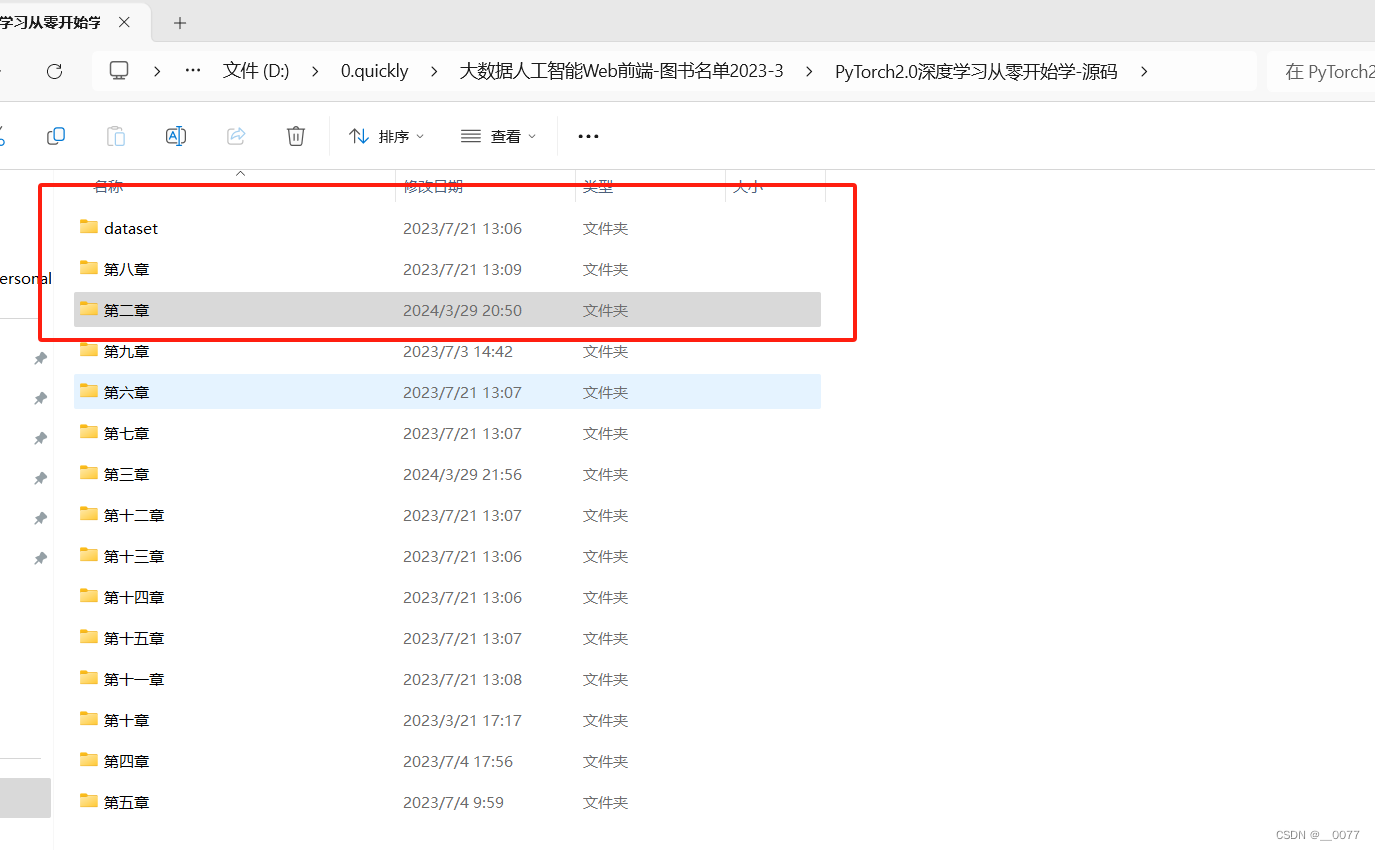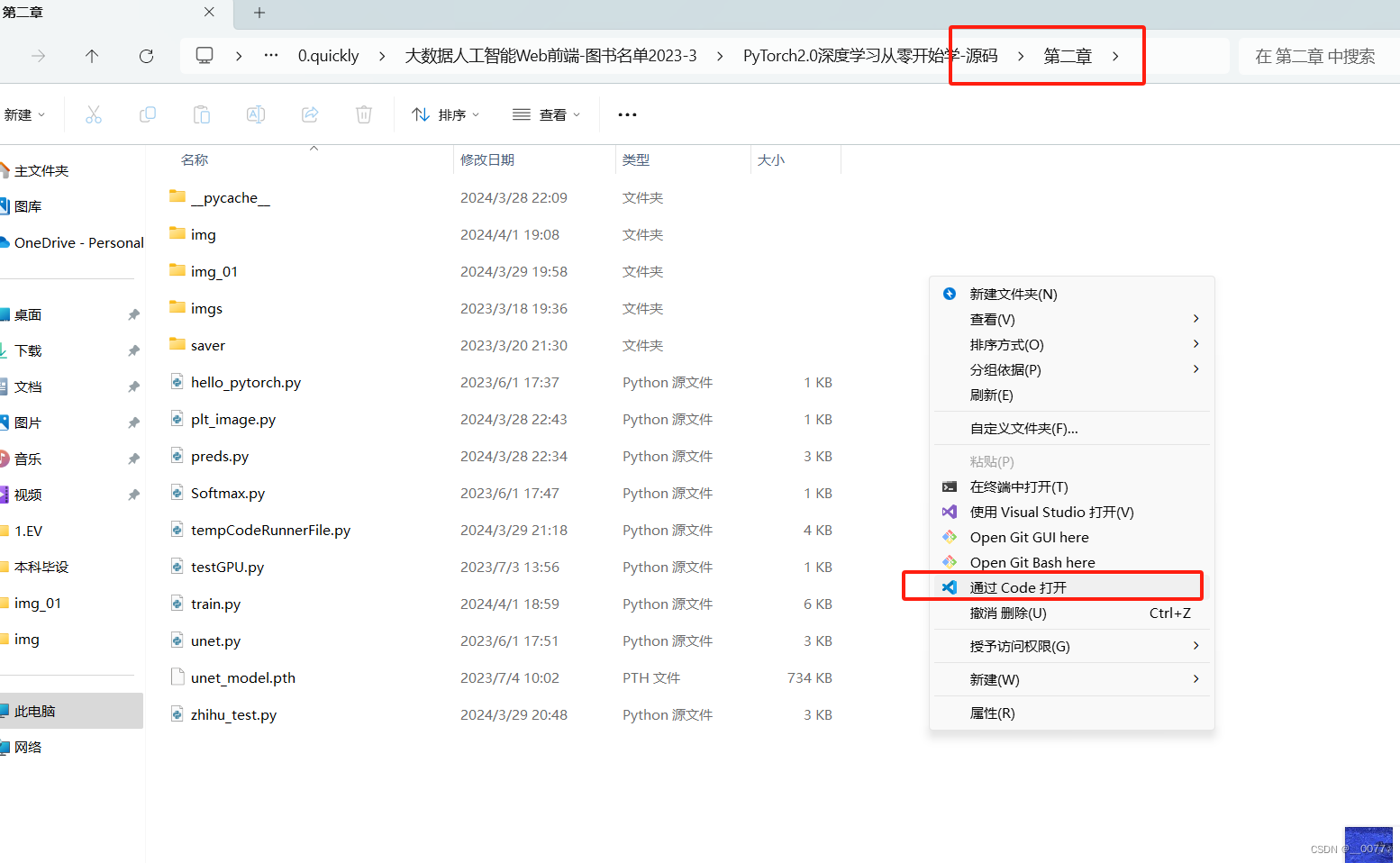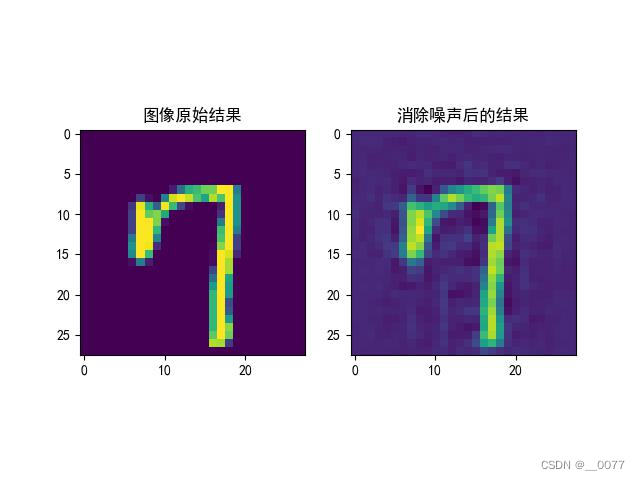热门标签
热门文章
- 1AGI|无GPU也能畅行无阻!Ollama大模型本地运行教程_ollama 本地部署
- 2软考系统架构师论文-论信息系统的架构设计_esb软件架构师论文
- 3未启用对服务器的远程访问/远程计算机已关闭/网络上不可用
- 4百度PaddlePaddle框架简易使用教程_百度plldasplldas
- 5面试题:数据库和缓存如何保证一致性?_数据库和缓存的数据一致性怎么保证
- 61.8.1 卷积神经网络近年来在结构设计上的主要发展和变迁——AlexNet
- 7Python3数据分析与挖掘建模(15)特征选择与特征变换_迁移学习rfe的案例代码
- 8毕业设计 - 地铁大数据客流分析系统 设计与实现_地铁客流预测系统
- 9TextRank原理解释
- 10Linux环境使用VSCode调试简单C++代码_linux vscode c++
当前位置: article > 正文
【Pytorch2.0学习记录 】第二章 深度学习环境搭建
作者:我家小花儿 | 2024-04-02 07:36:48
赞
踩
【Pytorch2.0学习记录 】第二章 深度学习环境搭建
环境搭建
参考的这篇帖子点我
2.3 基于pytorch2.0的图像去噪
疑问:
1、莫非是我输出图像错了,总感觉这一章使用的训练集,训练的图像没有噪点。。。
2、归一化处理测试样本,应该除以255吧?文心也说应该除以255,不知道源码里的512有什么含义。
x_train = np.reshape(x_train_batch, [-1, 1, 28, 28]) #修正数据输入维度:([30596, 28, 28])
# 归一化处理测试样本?????????
x_train /= 512.
- 1
- 2
- 3
解决的问题:
下面这行代码 ,"…“表示父目录,“…/ ” 表示返回上一级目录,【dataset】文件夹跟【第二章】文件夹并列,当我们在【第二章】文件夹下打开IDE,执行train.py 文件时,”…"便等同于“源码\第二章”,再执行以下语句,便可以找到【dataset】文件夹。
x_train = np.load("../dataset/mnist/x_train.npy")
- 1


源码\第二章\train.py
import os os.environ['CUDA_VISIBLE_DEVICES'] = '0' #指定GPU编号 import torch import numpy as np import unet import matplotlib.pyplot as plt from tqdm import tqdm batch_size = 320 #设定每次训练的批次数 epochs = 1024 #设定训练次数 #device = "cpu" #Pytorch的特性,需要指定计算的硬件,如果没有GPU的存在,就使用CPU进行计算 device = "cuda" #在这里读者默认使用GPU,如果读者出现运行问题可以将其改成cpu模式 device = torch.device("cuda" if torch.cuda.is_available() else "cpu") model = unet.Unet() #导入Unet模型 model = model.to(device) #将计算模型传入GPU硬件等待计算 #model = torch.compile(model) #Pytorch2.0的特性,加速计算速度 optimizer = torch.optim.Adam(model.parameters(), lr=2e-5) #设定优化函数/器【Adam】 梯度下降。。。的 #载入数据 x_train = np.load("../dataset/mnist/x_train.npy") y_train_label = np.load("../dataset/mnist/y_train_label.npy") x_train_batch = x_train x_train2=x_train # x_train_batch = [] # for i in range(len(y_train_label)): # if y_train_label[i] <= 10: #为了加速演示作者只对数据集中的小于2的数字,也就是0和1进行运行,读者可以自行增加训练个数 # x_train_batch.append(x_train[i]) x_train = np.reshape(x_train_batch, [-1, 1, 28, 28]) #修正数据输入维度:([30596, 28, 28]) # 归一化处理测试样本????????? x_train /= 512. train_length = len(x_train) * 20 #增加数据的单次循环次数 state_dict = torch.load("./saver/unet.pth") model.load_state_dict(state_dict) for epoch in range(epochs): train_num = train_length // batch_size #计算有多少批次数 train_loss = 0 #用于损失函数的统计 optimizer.zero_grad() #对导数进行清零!!!!!!!!!!! for i in tqdm(range(train_num)): #开始循环训练 x_imgs_batch = [] #创建数据的临时存储位置 x_step_batch = [] y_batch = [] # 对每个批次内的数据进行处理 for b in range(batch_size): img = x_train[np.random.randint(x_train.shape[0])] #提取单个图片内容 x = img y = img x_imgs_batch.append(x) y_batch.append(y) #将批次数据转化为Pytorch对应的tensor格式并将其传入GPU中 x_imgs_batch = torch.tensor(x_imgs_batch).float().to(device) y_batch = torch.tensor(y_batch).float().to(device) pred = model(x_imgs_batch) #对模型进行正向计算 loss = torch.nn.MSELoss(reduction="sum")(pred, y_batch)*100. #使用损失函数进行计算 #这里读者记住下面就是固定格式,一般而言这样使用即可 ###########################################3 loss.backward() #损失值的反向传播 optimizer.step() #对参数进行更新 train_loss += loss.item() #记录每个批次的损失值 #计算并打印损失值 train_loss /= train_num print("train_loss:", train_loss) if epoch%6 == 0: torch.save(model.state_dict(),"./saver/unet.pth")#要么存这里,要么存内存里了,类里面了 #下面是对数据进行打印 ran_img=np.random.randint(x_train.shape[0]) image = x_train[ran_img] #随机挑选一条数据进行计算 plt.rcParams['font.sans-serif']=['SimHei'] plt.rcParams['axes.unicode_minus'] = False plt.subplot(121) plt.title('图像原始结果') plt.imshow(x_train2[ran_img]) image = np.reshape(image,[1,1,28,28]) #修正数据维度 image = torch.tensor(image).float().to(device) #挑选的数据传入硬件中等待计算 image = model(image) #使用模型对数据进行计算 image = torch.reshape(image, shape=[28,28]) #修正模型输出结果 image = image.detach().cpu().numpy() #将计算结果导入CPU中进行后续计算或者展示 #展示或计算数据结果 plt.subplot(122) plt.rcParams['font.sans-serif']=['SimHei'] plt.rcParams['axes.unicode_minus'] = False plt.title('消除噪声后的结果') plt.imshow(image) plt.savefig(f"./img/img_{epoch}.jpg") plt.show()
- 1
- 2
- 3
- 4
- 5
- 6
- 7
- 8
- 9
- 10
- 11
- 12
- 13
- 14
- 15
- 16
- 17
- 18
- 19
- 20
- 21
- 22
- 23
- 24
- 25
- 26
- 27
- 28
- 29
- 30
- 31
- 32
- 33
- 34
- 35
- 36
- 37
- 38
- 39
- 40
- 41
- 42
- 43
- 44
- 45
- 46
- 47
- 48
- 49
- 50
- 51
- 52
- 53
- 54
- 55
- 56
- 57
- 58
- 59
- 60
- 61
- 62
- 63
- 64
- 65
- 66
- 67
- 68
- 69
- 70
- 71
- 72
- 73
- 74
- 75
- 76
- 77
- 78
- 79
- 80
- 81
- 82
- 83
- 84
- 85
- 86
- 87
- 88
- 89
- 90
- 91
- 92
- 93
- 94
- 95
- 96
- 97
- 98
- 99
- 100
- 101
- 102
- 103
- 104
- 105
结果:只训练了几次,左边是直接输出的训练集原始图像,这样输出的,不知道对不对




声明:本文内容由网友自发贡献,不代表【wpsshop博客】立场,版权归原作者所有,本站不承担相应法律责任。如您发现有侵权的内容,请联系我们。转载请注明出处:https://www.wpsshop.cn/w/我家小花儿/article/detail/351217
推荐阅读
相关标签



